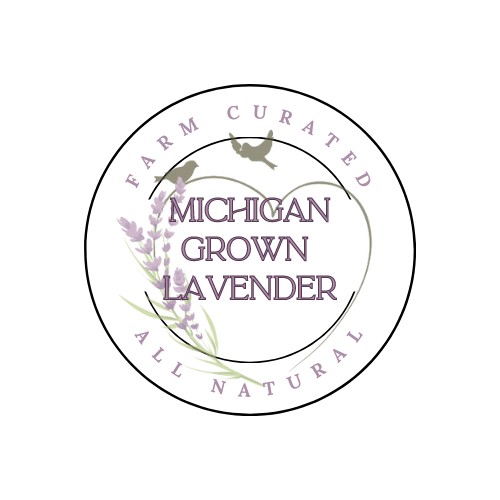As a licensed “Small Scale Nursery Grower” in Michigan that specializes only in Lavender plant offerings, we often get told “I always kill lavender plants” by lavender lovers browsing our lavender plants! We then proceed to ask our valued guests about their lavender plant procedures as Michigan is a fabulous environment to grow lavender and it is hard to kill – once established!
We often identify the problem as “you gave your lavender too much love.” Fact of the matter is that lavender plants dislike water, dislike nutrients, dislike you fawning all over them like they are some “regular” plant. Nope, think of lavender is a very independent plant that has different needs and wants in order to thrive. Established lavender plants thrive basically on neglect and adapt to their environment once established.
We have herds of deer stomping on (but not eating) our lavender plants year round, we have even had trees and large branches fall on our lavender, we have had an abundance of rain at times and long droughts at times and all is good in our lavender world!
Lavender plants dislike nutrients so excessive fertilization will have your lavender plant say “peace out” quickly when you give them too much, or the wrong kind of, fertilizer. Established lavender plants dislike water so adding irrigation to your plant coupled with bark mulch touching and holding moisture on the plant is an insurance policy for a slow death sentence.
We love being a resource for Michiganders to learn how to grow lavender. We even have a “demonstration lavender field” designed to show our guests how to create the perfect lavender growing conditions. This field also showcases 19 different varieties of lavender that grow easily in Michigan! The general public does not know that there are over 400 varieties of lavender plants that are not just purple but blue, pink and white! We love to see the surprise in our guests faces when they learn that new fun fact about lavender!
Our lavender farm is open seasonally from mid-May through mid-October and we invite Michiganders and (we love) tourists as well to stop by during open farm hours to learn about all things lavender: from plants to natural plant derived products!
Best Practices for Growing Lavender in Michigan
Identify USDA Grow Zone
The absolute first thing you need to do is identify your USDA hardiness grow zone to make sure you acquire the perfect lavender plants suited for your climate.

Pick Out Lavender Varieties Suited for Your Climate

Now is the time to pick out types of lavender plants suitable for your climate. All of our lavender plants grown & sold are suitable for the grow zones in the lower peninsula of Michigan. Here is a description of the types of lavender found on our farm (2024.)
Many large scale nursery growers will not have the USDA grow zone readily available for lavender, because it is just another plant they sell. Make sure you do your online research to identify which types of lavender are best grown in your climate, no matter where you acquire your lavender plants!
Identify Soil Type
This is a very important step before you put a single lavender plant in the soil. Lavender originated in the Mediterranean and loves well draining, rocky and sandy soil. This is probably one reason lavender thrives in Michigan: because Michigan has mostly sandy well draining soil.
If your soil is sand, feel free to move on to the next steps to get your lavender in the ground!
If your soil is heavy or clay, you must amend your soil to make it lavender-friendly!
Where to Plant Lavender: Identify Location
Lavender is a sun worshipper! Plant your lavender in the most sunny location on your property. The southwest side is most preferable, many people have luck near their mailboxes as well!
Lavender will perish from the cold Michigan winter winds. A wind block is helpful if you do not plan on covering your lavender for the winter. Consider putting in a row of lilacs or any other Michigan climate-loving bushes, such as hydrangeas, to help provide that wind block. Large amounts of lake effect snow from the Great Lakes will protect your lavender. If you are fortunate enough to live in a lake effect snow belt, snow cover should be sufficient. Trees stands with heavy forest undergrowth within 500 feet of lavender provide a natural wind block also! Just make sure those trees are not shading your lavender plants or the plants will turn out “leggy.” Leggy is OK and they still produce, just not as well as full sun. We have many areas on our farm with lavender in partial shade.
Here is some 5th season munstead lavender planted in partial shade:

Planting lavender on a slope will assist with drainage and water logging that lavender HATES. Avoid planting at the bottom of a slope or in gullies where water tends to pool.
What Months Should You Plant Lavender in Michigan?
Plant your lavender from the first warm opportunity until mid-October. We have done plenty of experimenting (because we have endless amounts of lavender) on where the threshold for Michigan lavender planting stands.
By “warm opportunity,” I mean a ten day forecast where it is 70 or above. We have planted as early as early April with the ten day warmth opportunity. Those baby plants experienced cold and snow before the “real warm up” and still survived. They also survived the subsequent winter(s) just fine.
If October still has those 70 or above days, continue to plant as long as 70 degree days are still in the ten day forecast.
Lavender needs about 2 weeks for those roots to establish before a cold streak!
How to Plant Lavender
Prepare your sandy or amended soil bed by adding a 2-4 inch pea gravel topper. A bonus if your pea gravel is amended with limestone. Lavender loves alkaline soil and the limestone will raise the pH of your soil over time.
The pea gravel’s main purpose will solve two problems. It will assist with keeping rain water from splashing on the plant (lavender hates water) and reflect sunlight back on to the plant (lavender loves sun.)

If planting multiple plants, measure distance and add landscape flags where you desire your lavender plants to be planted.
Dig your holes twice the size of the lavender root ball. We use an auger with a cordless drill to drill the holes, this is a HUGE time saver when planting a large amount of lavender.
Lavender loves nutrient-poor soil and sand delivers exactly what lavender needs. Unfortunately, Michigan’s sandy soil is also acidic. Adding a tablespoon or two of dolomite lime 4-5 inches from the base of the newly planted lavender will help deliver the exact nutrients that will benefit lavender.
Water to Establish Lavender
Lavender HATES water once it is established but needs copious amounts of water for 2-3 weeks during the establishment phase. If it is not raining during the establishment period, manually water small amounts several times a day.
How to Take Care of Your Established Lavender Plants
Lavender thrives on neglect but still needs a little attention. Think of lavender as a low maintenance beautiful lady.
Pruning Lavender
Lavender does need to be pruned 2x a year. Lightly in the spring and heavily after harvest.
If your lavender plant is on the “struggle bus” or knocking on death’s door you can heavily prune lavender to 6-9 inches above the base. You will have nothing to lose if it dies. If there is some life left in the lavender, you will see some green sprout out of the woody pruned parts.
Fertilizing Lavender
I prefer to call this “soil conditioning.” Remember: lavender does not like nutrients! The struggle with sandy soil and nutrients is real. Dolomite lime contains the perfect amount of nutrients that makes lavender thrive. Add 1/4 cup of dolomite lime 4-6 inches from the base of the plant every spring when lavender plants are “waking up” from dormancy, apply another 1/4 cup of dolomite lime after harvest.
Proper Harvesting Techniques
Proper harvesting techniques will help your lavender plant over time. Many large scale harvesters will just chop their lavender plants with a sickle. This method could damage your lavender plant! Instead, harvest stem by stem, by looking for the new growth under the second or third set of leaves under the stem!
Our Success Depends on Your Success!
We love being a resource for our guests. Our success with growing and selling healthy lavender plants to repeat, happy customers depends on your success!
Troubleshooting: Why is Your Lavender Plant Dying or Dead?
We love to utilize our 5 years of lavender germinating, propagating and growing experience to help our guests troubleshoot the reasons why their lavender plant may be dying or dead.

Live English Lavender Plant 6 Pack For Sale | Hydroponic Starts
Buy Lavender Plants in a 6 Pack and Save!
This English lavender plant offering is for six different varieties of “grower’s choice” rooted starter lavender plugs. You will be pleasantly surprised with our different varieties of lavender: we have purples, blues, pinks and white! Comes with planting and care instructions.
Renee started out as an avid real estate blogger in 2006. Opting for a less stressful life, Paul and Renee moved to Michigan in 2018 and started a lavender farm in 2019.
There are very few resources available to aspiring lavender farmers for growing lavender, lavender aromatherapy and lavender culinary infusion.
Renee hopes to change and shake up the world of lavender by sharing her knowledge and experience she has gained by being a lavender farmer and aromatherapist with lavender lovers all over the world.
Discover more from Twin Flame Lavender Farm Michigan
Subscribe to get the latest posts sent to your email.














